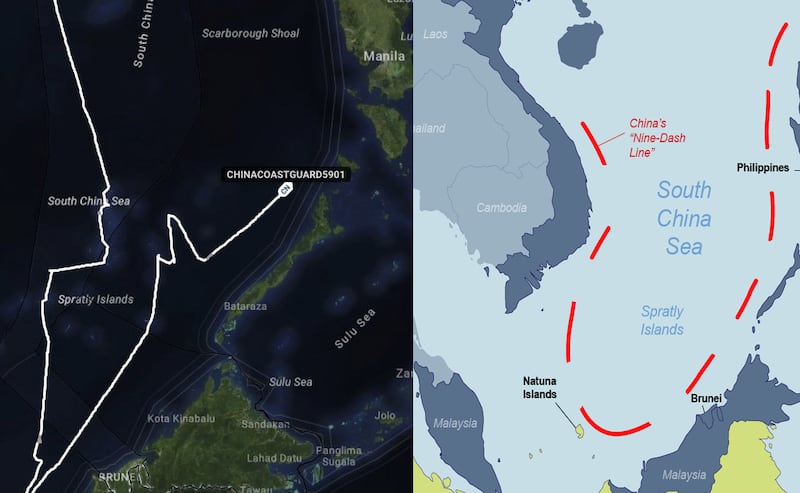Chinese coast guard ship CCG 5901, dubbed “The Monster” for its size, has conducted a patrol along the so-called nine-dash line that China drew to claim most of the South China Sea, said maritime experts.
The vessel appears to have returned to base in Hainan island after a ten-day tour through neighboring countries’ waters.
“The patrol serves the purpose of reaffirming China’s nine-dash line, but also sending a warning message to the Philippines as it passed through six sensitive Philippine locations,” said Ray Powell, director of the SeaLight project at Stanford University, who has tracked the ship’s movement over the last ten days in a map that shows a U-shaped path resembling the line.

Manila and Beijing have been confronting each other over some disputed reefs in the South China Sea that lie within Philippine waters but also inside the nine-dash line.
The self-claimed line is described by Chinese scholars as “historic” and is featured on Chinese maps as a set of nine, sometimes 11, segments that encircle up to 90% of the regional waterway.
Beijing uses it to demarcate territorial claims over most of the South China Sea, including sections that fall within areas claimed by Vietnam, the Philippines and other countries.
An international arbitration tribunal in a case brought by the Philippines in 2016 ruled that China’s claim to “historic rights” is unlawful, but Beijing declared the ruling “null and void” and refused to recognize it.
Related stories
[ Vietnam's South China Sea island building sets record in 2024: reportOpens in new window ]
[ US condemns China’s ‘escalatory’ actions in the South China SeaOpens in new window ]
[ Chinese ‘monster’ ship keeps pressure on Vietnam’s oil fieldsOpens in new window ]
China has been making efforts to reinforce the nine-dash line, especially with the presence of its large coast guard and maritime militia fleets.
The 12,000-ton CCG 5901 is currently the biggest coast guard vessel in the world – far larger than the size of a U.S. Navy Ticonderoga-class guided missile cruiser.
The ship, armed with heavy machine guns, also has a helicopter platform and a hangar large enough to accommodate larger rotary wing aircraft.
The last time “The Monster” turned on its AIS, or automatic information system, was at 9:50 p.m. UTC on June 26, when it was about 100 nautical miles (185 km) east of Sanya in southern Hainan, according to data from the tracking website MarineTraffic.
MarineTraffic uses AIS signals to track ships but the Chinese vessel has mostly been running “dark”, or not broadcasting AIS, since leaving the Sanya base on June 17, 2024.
‘Vexing problem’ for ASEAN
Philippine coast guard spokesperson Jay Tarriela has confirmed that the CCG 5901 was last monitored in the morning local time at a distance of 46 nautical miles (85 km) from Sanya.
In a post on the social platform X, Tarriela said that using Canada's dark vessel detection technology, his force has recreated the past track of the Chinese coast guard vessel.
According to the spokesman, the CCG 5901 “directly encroached upon the territorial waters” of the Philippines, “violating our sovereignty.”
On June 19, it was spotted at Thitu, or Pag-Asa island, under the Philippines’ control. It spent a night at Subi Reef – an artificial island that China has militarized – before passing Union Banks and entering Malaysia’s waters on June 20.
Malaysian law enforcement ships were shadowing the Chinese vessel in the waters near Luconia Shoals, also claimed by China, on June 21-23.
On June 24, the vessel was patrolling near the Second Thomas Shoal, known locally as Ayungin Shoal, where a week prior the Philippine military and the Chinese coast guard had a tense stand-off resulting in a Filipino sailor losing a finger.
The shoal is only 195 km (121 miles) from the Philippines’ Palawan island but lies within China’s nine-dashed line.
Earlier this year, the CCG 5901 made several intrusive long-term tours near some oil fields in Vietnam’s exclusive economic zone, orEEZ, where Hanoi has exclusive access to the natural resources in the waters and in the seabed.
The presence of Chinese coast guard vessels, including “The Monster,” in regional countries’ EEZs is “an old and increasingly vexing problem which ASEAN should, but unfortunately have no coordinated response to,” said Kwa Chong Guan, senior fellow at S. Rajaratnam School of International Studies in Singapore.
ASEAN members Brunei, Indonesia, Malaysia, the Philippines and Vietnam all have overlapping EEZs in the South China Sea.
“ASEAN needs new policy initiatives on the South China Sea,” Kwa told BenarNews, a RFA-affiliated news service. “Perhaps Malaysia as the next Chair of ASEAN in 2025 could rise to the occasion and lead the association to propose some.”
BenarNews reporter Nisha David in Kuala Lumpur contributed to this report.
Edited by Mike Firn and Taejun Kang.
